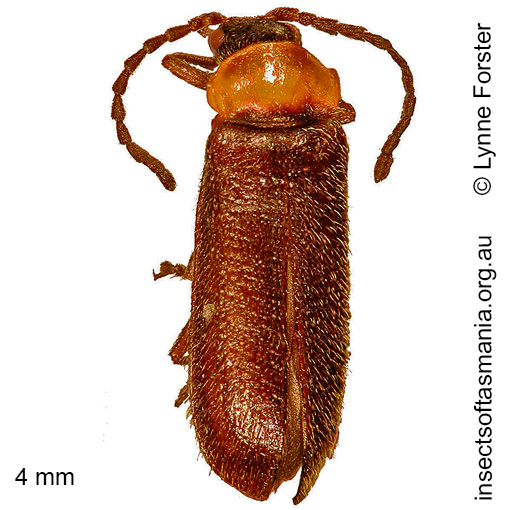
Heteromastix nigripes (a species of soldier-beetle)
Basis for Tasmanian occurrence
Classification
Suborder: Polyphaga
Superfamily: Elateroidea
Family: Cantharidae
Subfamily: Dysmorphocerinae
Morphology
Flightedness: winged and assumed capable of flight
Morphology (characterised by L. Forster): — Antennae simple in both sexes, long and moderately stout; males with apical segment constricted in middle; second segment a third the length of third segment; 11th segment about twice as long as 10th — Elytra dark with short, moderately dense pubesence — Head dark, strongly convex — Legs entirely dark — Pronotum strongly transverse, yellowish (base sometimes stained black), not notched at base — Wings present — Wings present.
Source literature on morphology and taxonomy (*primary taxonomic source, where identified):
*Lea, A.M. (1909). Revision of the Australian and Tasmanian Malacodermidae. Trans. Roy. Entom. Soc. Lond. 1909: 45-251. [Pages 131, 141].
Ecology
Association with dead wood or old trees: obligately saproxylic
Ecological attributes: — Affiliated with older trees (Harrison, 2007) — May occupy logs or trunks of Eucalyptus obliqua, at least temporarily, since found having emerged within a year of felling (Grove & Bashford, 2003) — May occupy logs or trunks of Eucalyptus obliqua, at least temporarily, since found having emerged within six years of felling (Grove et al., 2009).
Collection method(s) for TMAG material: — Emergence trapping from log of Eucalyptus obliqua — Flight intercept trapping (trough below Malaise trap) — Hand collection (substrate not specified) — Hand collection from flowers of Eucryphia lucida (Ettershanks & Ettershanks, 1993) — Hand collection from flowers of Eucryphia milliganii (Ettershanks & Ettershanks, 1993) — Hand collection from flowers of Helichrysum purpurascens (Ettershanks & Ettershanks, 1993) — Hand collection from flowers of Leptospermum sp. (Ettershanks & Ettershanks, 1993) — Knockdown fogging of canopy of Nothofagus cunninghamii — Malaise trapping — Pitfall trapping — Sticky trapping on Eucalyptus obliqua.
Source ecological literature:
Grove, S.J. & Bashford, R. (2003). Beetle assemblages from the Warra log decay project: insights from the first year of sampling. Tasforests 14: 117-129.
Grove, S.J. (2009b). Beetles and fuelwood harvesting: a retrospective study from Tasmania’s southern forests. Tasforests 18: 77-99.
Baker, S.C. (2000). Forest litter beetles and their habitat: a comparison of forest regenerated by wildfire and logging practices. Hons. thesis, Univ. of Tasmania, Hobart.
Baker, S.C. (2006b). Ecology and conservation of ground-dwelling beetles in managed wet eucalypt forest: edge and riparian effects. PhD thesis, Univ. of Tasmania, Hobart.
Grove, S. et al. (2009). A long-term experimental study of saproxylic beetle … succession in Tasmanian Eucalyptus … logs… In: Fattorini, S. (Ed.), Insect Ecology and Conservation. Research Signpost, pp. 71-114.
Harrison, K.S. (2007). Saproxylic beetles associated with habitat features in Eucalyptus obliqua trees in the southern forests of Tasmania. PhD thesis, Dept. of Zoology, Univ. of Tasmania, Hobart.
Yee, M. (2005). The ecology and habitat requirements of saproxylic beetles native to Tasmanian wet eucalypt forests: potential impacts of commercial forestry practices. PhD thesis, Univ. of Tasmania, Hobart.

